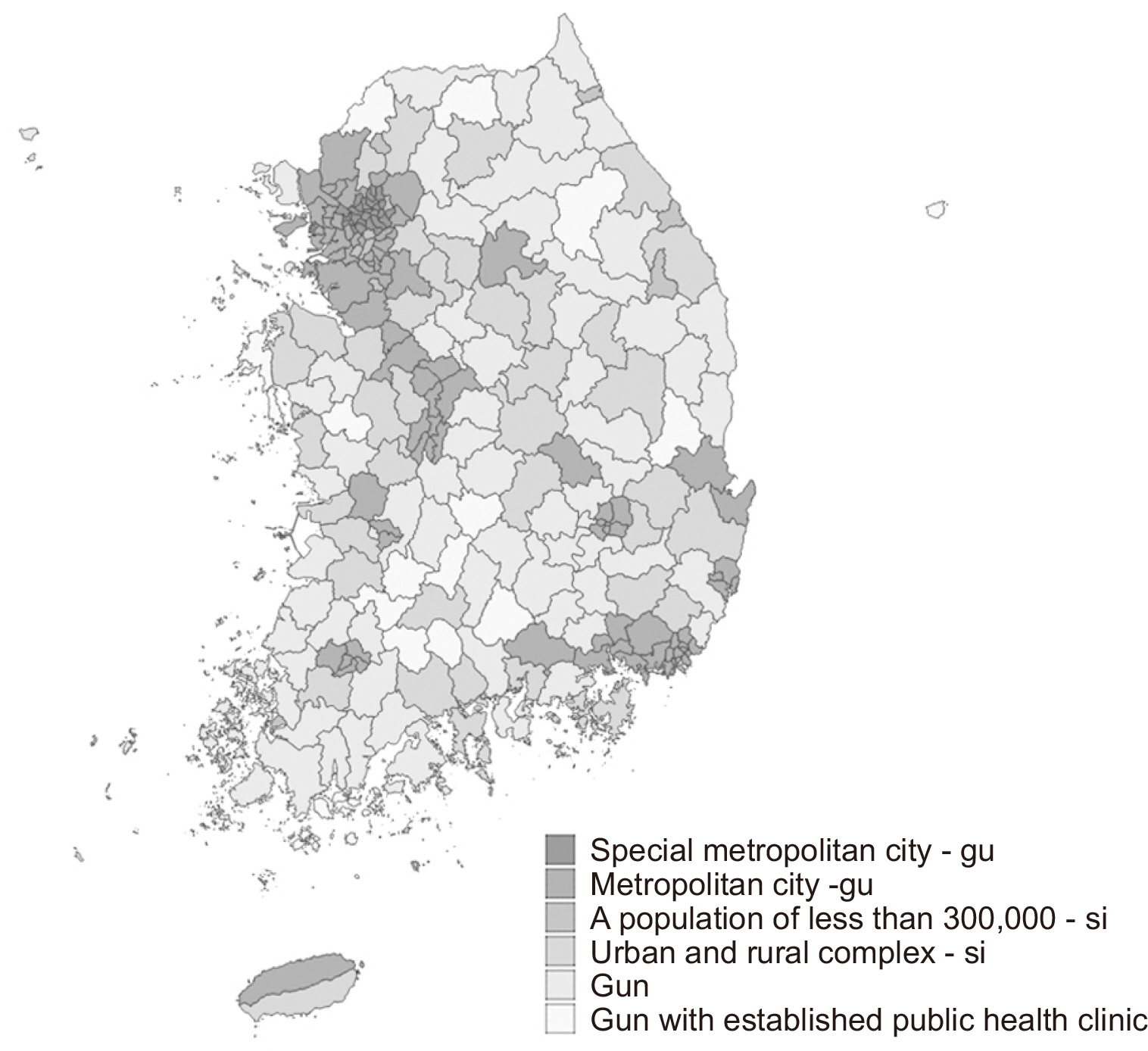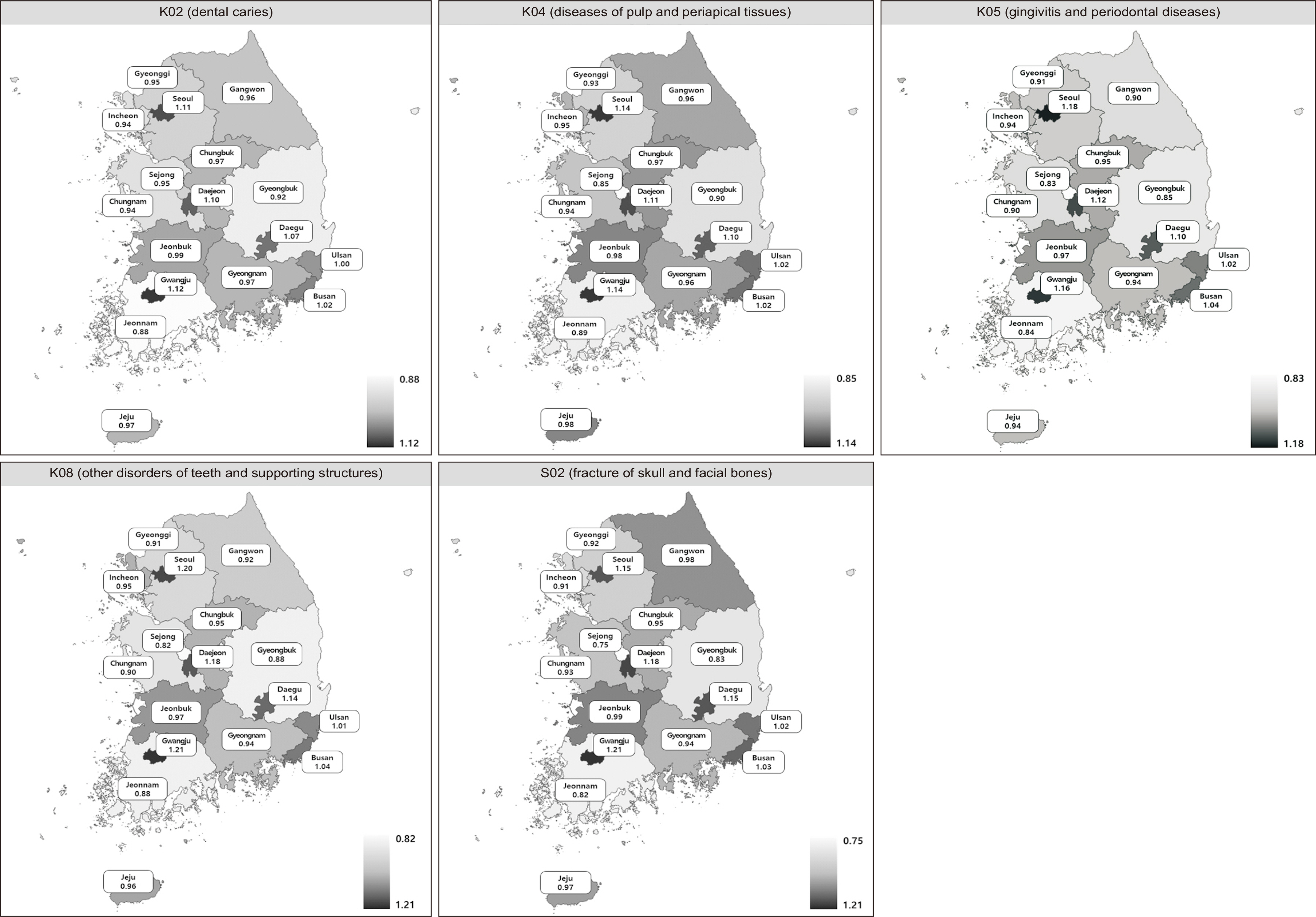J Korean Acad Oral Health.
2024 Jun;48(2):64-70. 10.11149/jkaoh.2024.48.2.64.
Disparities in dental healthcare utilization based on regional characteristics in Korea
- Affiliations
-
- 1Department of Preventive Dentistry, School of Dentistry, Kyungpook National University, Daegu, Korea
- 2Institute for Translational Research in Dentistry, Kyungpook National University, Daegu, Korea
- KMID: 2556596
- DOI: http://doi.org/10.11149/jkaoh.2024.48.2.64
Abstract
Objectives
This study aimed to analyze dental healthcare resources and utilization patterns according to regional characteristics in Korea and to compare disparities in unmet dental care need rates and subjective oral health status.
Methods
Dental healthcare resources and utilization patterns were analyzed using data from the National Health Insurance Statistics (NHIS) and the Population and Housing Census (2022). Descriptive statistics were performed on the distribution of dental healthcare resources, such as dental institutions, dentists, and dental hygienists per 100,000 people. Inflow and outflow indices for healthcare utilization were calculated using the number of days of inpatient and outpatient visits for oral diseases. In addition, the association between the type of local governance and unmet oral healthcare needs, as well as subjective oral health status, was analyzed using the chi-square test with the Community Health Survey (2022) data.
Results
The number of dental institutions, dentists, and dental hygienists (per 100,000 people) in rural areas (such as “Urban and rural complex - si,” “Gun,” and “Gun with an established public health clinic”) was lower than in urban areas (such as a “[Special] metropolitan city”). The inflow and outflow indices for healthcare utilization by oral disease indicated higher outflows of patients to metropolitan areas. Furthermore, the chi-square analysis revealed that, for the “Gun with an established public health clinic,” more respondents reported unmet dental care needs and poor subjective oral health status (P<0.05).
Conclusions
Dental healthcare resources were concentrated in metropolitan areas, and a relatively higher frequency of experience of unmet dental care needs was observed in rural areas. Therefore, policy responses are required to address the disproportionate distribution of dental healthcare resources according to regional factors.
Keyword
Figure
Reference
-
References
1. Im SK. 2023. National Health Insurance Fiscal Projections 2023-2032. National Asscembly Budget Office;Seoul: p. 40–44.2. Health Insurance Review and Assessment Service. HIRA Bigdata Open Portal, Medical Statistics on Diseases. Medical Statistics for Service. High Prevalence Diseases Statistics DB [Internet]. Available from: https://opendata.hira.or.kr/op/opc/olapHifrqSickInfoTab1.do. cited 2024 Feb 5.3. Kim HS. 2023; The special reason for oral health inequality-for patients who cannot overcome the dental threshold. Journal of Med Soc. 114–126.4. Atun R. 2004. What are the advantages and disadvantages of restructuring a health care system to be more focused on primary care services? WHO Regional Office for Europe;Copenhagen: p. 5–10.5. Yoon TH. 2010; Regional health inequalities in Korea the status and policy task. JCSW. 30:49–77.6. Lee JH. 2016; The regional health inequity, and individual and neighborhood level health determinants. Health and Social Welfare Review. 36:345–384. DOI: 10.15709/hswr.2016.36.2.345.7. Office for Government Policy Coordination. Government Performance Evaluation Portal, National Agenda. National Vision·Objectives·Commitments [Internet]. Available from: https://www.evaluation.go.kr/web/page.do?menu_id=54. cited 2024 Feb 13.8. Kim DJ. 2015; Inequality in healthcare utilization and health status in South Korea. Health and Welfare Issues & Focus. 280:1–8.9. Park KD. 2012; A study on eegional disparities in healthcare utilization: using spatial dependence. The KAPS. 21:388–415.10. Bodenheimer T, Grumbach K. 2009. Understanding health policy: a clinical approach. McGraw-Hill Companies Inc;New York: p. 17–30.11. Jeon BY, Choi SM, Kim CY. 2012; Socioeconomic equity in regional distribution of health care resources in Korea. Health Policy and Managemnet. 22:85–108. DOI: 10.4332/KJHPA.2012.22.1.085.12. World Health Organization. 2023. Draft Global Oral Health Action Plan (2023-2030). World Health Organization;Switzerland: p. 18–32.13. Griffith JR. 1972. Quantitative techniques for hospital planning and control. Lexington Books;Lexington: p. 1–403.14. Oh MR, Jeon BG, Lee JH, Jeong TO, Heo T. 2019; Inflow and outflow type analysis of emergency department patients of the Honam region. J Korean Soc Emerg Med. 30:348–354.15. Byeon JH, Park IH, Lim MH. 1990. A study on the operational status of public health clinic. Korea Institute for Health and Social Affairs;Sejong: p. 1–2.16. National Geography Information Institute. 2021. The national atlas of korea III. Ministry of Land Infrastructure and Transport;Sejong: p. 98–113.17. Marmot M, Friel S, Bell R, Houweling TAJ, Taylor S. 2008; Closing the gap in a generation: health equity through action on the social determinants of health. The Lancet. 372:1661–1669. DOI: 10.1016/S0140-6736(08)61690-6. PMID: 18994664.18. Oh YS, Lee J. 2023; Discussion on the distribution of social welfare tasks and financial burden sharing between metropolitan and local autonomous entities: focusing on the city of Busan. Health and Social Welfare Review. 43:194–210.19. Park EC. 2021; Strategies for improving healthcare delivery system in Korea. HIRA Res. 1:9–15. DOI: 10.52937/hira.21.1.1.9.20. Kim JH, Kim YK, Kim HT. 2000; Analysis of pattern of dental emergency patients and initial emergency treatment. JKDA. 38:656–663. DOI: 10.1097/01.EEM.0000292329.01773.5e.21. Andersson L, Andreasen JO, Day P, Heithersay G, Trope M, Diangelis AJ, et al. 2012; International association of dental traumatology guidelines for the management of traumatic dental injuries: 2. Avulsion of permanent teeth. Dent Traumatol. 28:88–96. DOI: 10.1111/j.1600-9657.2012.01125.x. PMID: 32460393.22. Lee YJ, Lee NR, Jung YS, Lee M, Jung HI, Choi YH. 2023; Awareness of the concept and role of public oral health care in Korea among oral health professionals. J Korean Acad Oral Health. 47:186–196. DOI: 10.11149/jkaoh.2023.47.4.186.23. Yu JW, Shin BM, Shin SJ, Bae SM. 2021; A study on the status of dental underserved areas in Korea. J Korean Soc Dent Hyg. 21:367–381. DOI: 10.13065/jksdh.20210036.24. Kim NH, Jeon JE, Chung WG, Kim DK. 2012; Social determinants related to the regional difference of unmet dental need in Korea. J Korean Acad Oral Health. 36:62–72. DOI: 10.11149/jkaoh.2012.36.4.323.
- Full Text Links
- Actions
-
Cited
- CITED
-
- Close
- Share
- Similar articles
-
- Horizontal inequities in dental service utilization
- Cancer History and Healthcare Utilization among Asian Adults Living in the United States: A Population-based Study
- Trends and disparities in avoidable, treatable, and preventable mortalities in South Korea, 2001-2020: comparison of capital and non-capital areas
- Necessity of Analyzing the Korea Community Health Survey Using 7 Local Government Types
- Critical Analysis of Unmet Healthcare Needs Index for Addressing Regional Healthcare Inequality



